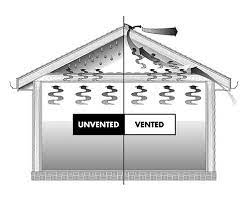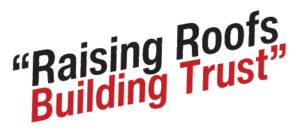Ventilation & Insulation
Roof Ventilation Upgrades

Proper roofing ventilation is a critical but often overlooked aspect of home maintenance. Effective ventilation helps regulate your attic’s temperature and moisture levels, preventing long-term damage to your roof, attic, and even the rest of your home. In this article, we’ll discuss the importance of roofing ventilation, common types of attic ventilation systems, and how they contribute to the health and longevity of your home.
Whether you’re building a new house, replacing your roof, or just maintaining your current one, understanding roofing ventilation is essential. Let’s dive into why it’s so important and how to ensure your home benefits from the right ventilation system.
What is Roofing Ventilation?
Roofing ventilation refers to the system of air intake and exhaust installed in your roof to allow the movement of air in the attic space. This air circulation helps regulate temperature and moisture, preventing problems like mold, mildew, wood rot, and even structural damage.

Without proper ventilation, heat and moisture can build up in your attic, leading to a host of issues, including:
- Increased Energy Costs: A poorly ventilated attic can lead to higher cooling and heating costs.
- Roof Damage: Excessive heat and moisture can deteriorate shingles, roofing materials, and even cause your roof to prematurely age.
- Mold and Mildew: Stagnant, warm air in the attic can lead to mold and mildew growth, which can spread to other areas of your home.
- Structural Damage: Unregulated moisture can weaken wooden beams and the framework of your roof, leading to costly repairs.
How Does Roofing Ventilation Work?
Roofing ventilation works by promoting the natural flow of air through your attic space. The system uses two main components:
- Intake Ventilation: Located at the eaves or soffits of the roof, intake vents allow cool, dry air to enter the attic.
- Exhaust Ventilation: Positioned near the ridge or peak of the roof, exhaust vents allow hot, humid air to escape from the attic.
This system of intake and exhaust ventilation creates a continuous flow of air, ensuring the attic remains properly ventilated. The balance between intake and exhaust is critical for optimal performance.
Types of Roofing Ventilation Systems
There are several types of roofing ventilation systems available, each designed to meet the needs of different home types and climates. Below are the most common types:
1. Ridge Vents (Exhaust Vents)

Ridge vents are installed along the peak of the roof. They allow hot air to escape from the attic naturally. When combined with soffit vents, ridge vents create an ideal balance of air circulation, allowing for effective ventilation. Ridge vents are particularly effective because they run along the entire ridge, ensuring a continuous exhaust of hot air from the attic.
2. Gable Vents
Located on the gable ends of the house (the triangular side walls of the roof), gable vents allow hot air to exit the attic. They are typically used in combination with soffit vents, but their performance depends on the design of the house. Gable vents can be more decorative than functional in some situations, so it’s important to make sure the system is designed for optimal airflow.
3. Soffit Vents (Intake Vents)

Soffit vents are installed under the eaves of your roof and allow cool air to enter the attic. These vents are usually installed in the soffit or fascia, which are the horizontal surfaces that run along the edges of your roof. Soffit vents are a crucial part of your ventilation system, as they ensure the intake of fresh air that helps push out warm, stale air through the exhaust vents.
4. Dormer Vents
Dormer vents are small vents located on dormers or small roof structures that protrude from the main roof. They are typically used on homes with dormer windows and help improve ventilation in specific parts of the attic. Dormer vents can be particularly useful for homes with complex rooflines.
5. Turbine Vents
Turbine vents are powered by wind and are often used on steeper-pitched roofs. These vents have a rotating design that increases airflow through the attic. They work well in areas where wind is frequent, but may not be as effective in regions with little wind or during hot, still days.
6. Power Vents
Power vents are electrically powered fans installed on the roof that help actively expel hot air from the attic. These vents are ideal for homes in warmer climates or areas that experience extreme temperatures. Power vents can be controlled by thermostats or humidistats, turning on automatically when certain temperature or humidity thresholds are reached.
7. Flat Roof Vents
For homes with flat roofs, a combination of intake and exhaust vents is typically installed along the edges of the roof. These systems are designed to direct airflow across the roof, helping to remove heat and moisture that may accumulate in the attic or under the roof membrane.
Why Roofing Ventilation is Important
Proper roofing ventilation is crucial for a variety of reasons, including:
1. Prevents Moisture Buildup
Excessive moisture can cause significant damage to your home, from wood rot to mold and mildew growth. When warm air in the attic rises and meets cooler surfaces, condensation forms. This moisture can damage insulation, framing, and roofing materials. Adequate ventilation ensures that moisture is consistently vented out of the attic before it becomes a problem.
2. Extends Roof Lifespan
Without proper ventilation, your roof can overheat, leading to premature aging of roofing materials like asphalt shingles. Heat buildup can cause shingles to warp, crack, and lose their granules. Proper ventilation helps regulate attic temperatures, preventing your roof from getting too hot and extending its lifespan.
3. Improves Energy Efficiency
Effective roof ventilation can reduce the load on your heating and cooling systems. In summer, a well-ventilated attic helps keep your home cooler by allowing hot air to escape, reducing the need for air conditioning. In winter, ventilation helps reduce ice dams by keeping the attic temperature consistent, preventing the melting and refreezing of snow on the roof.
4. Promotes Healthy Indoor Air Quality
Ventilation helps reduce the buildup of moisture and pollutants in the attic, which can eventually seep into the living spaces below. By ensuring proper air circulation, you can reduce the risk of indoor air quality problems, including mold, mildew, and allergens.
Signs You Need Roofing Ventilation
If your home is experiencing any of the following issues, it may be time to evaluate or upgrade your roofing ventilation system:
- High Energy Bills: If your cooling or heating costs are consistently high, your attic may not be properly ventilated.
- Condensation in the Attic: Dampness or water droplets on the underside of the roof or insulation could indicate poor ventilation.
- Sagging Roof: Warped or damaged roof materials can be a sign of excessive heat or moisture buildup due to improper ventilation.
- Mold or Mildew: If mold or mildew is visible in your attic or on the roof structure, poor ventilation could be the cause.
- Hot Attic: An attic that feels excessively hot, even in mild weather, is a sign that heat isn’t properly escaping.
How to Improve Roofing Ventilation
If you believe your roof lacks proper ventilation or your system needs an upgrade, consider these steps:
- Consult a Roofing Professional: 616 Roofing & Exteriors can assess your current ventilation system and recommend solutions based on your home’s design and climate.
- Install Soffit Vents and Ridge Vents: These two systems are typically the most efficient at promoting balanced air circulation and can be added to most homes.
- Add Power or Turbine Vents: If you live in a particularly hot climate, consider adding powered or turbine vents for increased airflow.
- Regular Inspections and Maintenance: Ensure your ventilation system is clean and free of debris to maintain optimal airflow.
Get a Ventilation Inspection Today
Roofing ventilation is an essential aspect of home maintenance that protects your home from moisture damage, heat buildup, and premature roof aging. By ensuring your home has adequate airflow, you can extend the life of your roof, improve energy efficiency, and protect your home’s structure.
If you’re unsure about your home’s roofing ventilation, let 616 Roofing & Exteriors assess your needs and recommend the right solutions. Proper ventilation not only ensures the health of your roof but also contributes to the overall comfort and safety of your home.
For Further Information: Roofing and Attic Space Ventilation: The Ultimate Guide to Protecting Your Home
Attic Insulation Impacts your Roof System
Along with the right ventilation, the right attic insulation increases the effectiveness of your roofing system, by ensuring no harmful moisture or heat from your home brings unwanted wear and tear on your roofing sublayers and shingles. Of course, it also keeps you warmer in the winter, and cooler in the summer – as well as keeping it quieter in your home. We can provide cellulose blow-factor, bringing it up to current standards.
For Further Information: Attic Insulation for Your Home: Essential Guide to Energy Efficiency and Comfort





